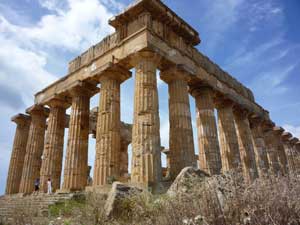About Selinunte
Selinunte is one of Sicily’s great Greek archaeological sites. Situated by the sea in the south-western corner of Sicily, the isolated ruins here have stood abandoned for most of their history. The lack of later development allows modern visitors to imagine the ancient town of Selinus as it would have been two and a half thousand years ago. The archaeological park at Selinunte is huge, incorporating Greek temples, ancient town walls, the ruins of residential and commercial buildings, countryside paths and zones not yet excavated. If you are interested in Greek Sicily, this is a very important site to visit, and the temples’ setting close to the sea is wonderfully picturesque. There are sandy beaches nearby, so a day out at Selinunte has a great deal to offer any traveller.
- Sicily destinations and practicalities: full menu (at foot of this page)
Visiting Selinunte: Practicalities
The archaeological park covers a very large area. Many visitors will never make it to the farthest ruins; if you want to explore thoroughly you should allow a minimum of 3-4 hours. Wear sensible shoes and take water, a hat and sun protection (even an umbrella to use as a parasol) in the summer. There are some shady spots in a valley within the site where you could picnic; we also found an enterprising local selling iced drinks half-way around. Opposite the entrance are souvenir stalls and a bar with tables where you can buy drinks, snacks and freshly-made rolls. Toilets are available by the first group of temples.
There is a little electric ‘train’ service which runs around the site on a couple of different-length itineraries. If you have mobility problems or a very rushed schedule, this might be worth paying for. It’s really much more pleasant, though, to wander around the site at your own pace and find moments of solitude among the ruins.
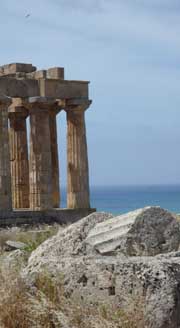
The archaeological park is open daily from 9am, closing at 5pm in the winter and 7pm in the summer. Like Italy’s other state-run museums and archaeological sites, Selinunte is free for EU visitors under 18, and reduced for 18-25 year olds. Sicily does have its own rules, but concessions generally also apply to students and to citizens of countries ‘with reciprocal arrangements’ so it’s worth asking if you’re not sure. Take passports or other proof of status. There’s a book and souvenir shop inside the entrance; it’s worth buying a map or guide to help you make sense of the site.
Ancient Selinunte: History, temples and archaeological site
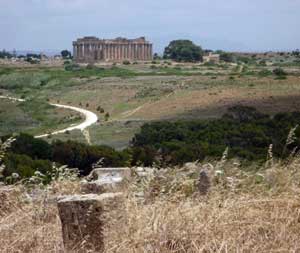
Selinunte – Selinus – actually wasn’t a huge city. It was a reasonable-sized town, but the scale of its temples indicate Selinunte had ideas high above its station. Founded in the seventh century BC by Greeks from Megara Hyblaea, itself a colony of Megara in Greece, Selinus was spread over a couple of low hills on the seashore. The town probably reached its peak in the sixth and fifth centuries BC, the era when its grand temples were constructed. In 409 BC Selinus was attacked, defeated and destroyed by the Carthaginians. There were later attempts to re-fortify the citadel, but the town’s greatest days were over.
After earthquakes shook the remaining buildings to bits in the Middle Ages, the site of Selinus was forgotten until its rediscovery in the sixteenth century. In the early nineteenth century English archaeologists began the work of excavation, which still goes on today.
On entering the archaeological park, the first sight you see is the grandest. The large Doric temple known as Temple E was re-erected in the 1950s and stands proudly on a rise. It is an impressive evocation of Sicily’s Greek past, and, unusually, visitors can climb into the temple itself to get a real sense of the scale and history of the building.
Behind Temple E are two more temples – this low hill would have been a sacred site outside the town centre. These temples are much more ruinous. The furthest from the entrance, Temple G, was a massively ambitious project that may never have been finished. It would have been one of the biggest temples of the ancient world, and the mound of masonry is still impressive today. Clambering among the sections of column is a memorable experience – it is interesting to get an idea of Greek construction techniques from the blocks of carved stone, to marvel at the scale and ambition of the building, and at the force of its ultimate destruction, at the hands of the Carthaginian conquerors and of later earthquakes.
From this eastern part of the site, visitors cross a shallow valley where Selinunte’s port once stood, and climb up to the heart of town on another low hill. The acropolis and more temples (one partially re-erected) were in this part of the city; the earliest part of Selinunte to be built and also the last to be inhabited by the survivors of the Carthaginian siege. At its heyday the town’s main residential areas covered the level ground inland from this hilltop; parts of the street layout have been excavated, though the ruins aren’t as striking as those in the main hilltop cluster.
On the western hill is a small museum which exhibits finds from the site and helps give an idea of how the temples – brightly painted and decorated – would have looked. Unfortunately the best portable remains, including the metopes – sculpture panels from the temple frieze – are now in the archaeological museum in Palermo.
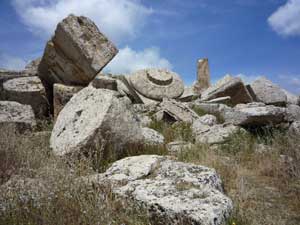
Despite the grandeur of Selinunte’s temples and the powerful images of its jumbled columns, the town’s domestic architecture can be at least as fascinating. A street of ruined shops is a compelling reminder of the everyday life in ancient Selinunte.
Some of the extant ruins at Selinunte are very poignant. After the big defeat in 409 BC, defensive walls built of existing masonry were thrown up in a desperate attempt to defend the nucleus of the city. A row of twelve narrow openings in the fortifications were supposedly designed for lines of men to run out in the town’s defence in the event of a military assault; not an enviable job.
If you have the time, you should walk onwards to Selinunte’s third major group of ruins, along a path to the west which leads through fields. By a stream you will find the remains of a very early sacred site, the Malophorus sanctuary. There is a simple temple here, sacrificial altars and a carefully constructed water course. This was evidently an important site used over a long period. Archaeologists found thousands of votive offerings, mostly terracotta figurines, here, and much of the Selinunte material exhibited in the Palermo archaeological museum is from this part of the site.
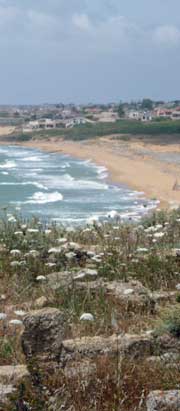
Marinella di Selinunte
Outside the entrance to the Selinunte archaeological park is the seaside village of Marinella, also called Marinella di Selinunte. It’s a fairly undistinguished modern settlement, making a living from fishing and its proximity to tourist Selinunte. Its sandy beaches and convenient location make it a decent place to stay for overnight visitors.
Castelvetrano
Selinunte lies in the comune (council district) of Castelvetrano, an important transport hub if you are relying on trains and buses. Castelvetrano is a busy and typical Sicilian town, which most travellers will only glimpse on the way to Selinunte (read on for travel details). It has some historical buildings and a lively main street lined with shops. If you have time, it is worth paying a visit to the town museum (Museo Civico) to see the Efebo di Selinunte, a fifth-century Greek bronze statue of a youth. Castelvetrano appears in the history books as the site of the death of controversial twentieth-century Sicilian bandit Salvatore Giuliano – a courtyard at Via Mannone 92-100 is where his body was found, though the true circumstances of his death in 1950 remain mysterious.
Cave di Cusa
If you are driving, consider making a detour from Selinunte to visit the Cave di Cusa, around thirteen miles away. These are the quarries used by the ancient Greeks of Selinus to supply the stone for building the town’s temples. Work stopped abruptly after Selinunte’s defeat, and today’s visitors can see great stone column sections, cut then abandoned. The Cave di Cusa site is to the south of the town of Campobello di Mazara.
Selinunte travel and transport
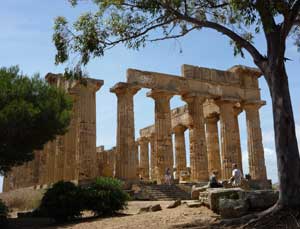
Selinunte’s only public transport connection is a bus from Castelvetrano, the nearest town. This is a cheap and simple journey, but you will need to plan ahead. To find the latest timetables, look under ‘tratte urbane‘ on the Salemi bus website, indicated in the links panel on the right, and find the timetable for the Marinella di Selinunte service. Note that some services run Monday-Saturday (feriali) and others run on Sundays and public holidays (festivi). The bus stops right outside the railway station in Castelvetrano, where there is a convenient cafe-bar which advertised (when we visited) basic tourist information and a luggage storage service. The bus ride lasts about half an hour and stops very close to the entrance to the archaeological site of Selinunte (ask the driver if it’s not clear which way to walk).
Castelvetrano can be reached by train; it is on the line which runs from Trapani (an hour away) and also stops at Marsala and Mazara del Vallo before reaching Castelvetrano. Trains continue to Palermo. There is also a useful bus service operated by a company called Lumia which connects Castelvetrano with other towns in this area including Sciacca and Agrigento. Salemi buses link Castelvetrano with Marsala and Palermo.
There is car parking outside the archaeological site at Selinunte.
Selinunte accommodation
Hotels and B&Bs
As Selinunte covers such a large site and takes a long time to visit, it makes a lot of sense to spend a night nearby and perhaps enjoy the beach as well. At Marinella there are some practical, though uninspiring, hotels. If you have a hire car, you could choose somewhere more appealing in the countryside nearby. Hotel Eracle, is a decent and affordable modern four-star with a restaurant in Marinella and close to the archaeological park. Other options include Il Vigneto Resort, offers contemporary-design accommodation in vineyards a short drive from Selinunte, while Case di Latomie is a rural retreat with a swimming pool and a restaurant serving local produce.
> Find accommodation in and around Selinunte
![]() Highlights
Highlights
Combine Selinunte with
Useful external links
